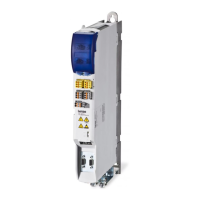Electrical installation
Installation according to EMC requirements
4-57
L
EDSVS9332S-B EN 3.0
4.3 Wiring according to EMC (installation of a CE-typical drive
system)
General notes • The electromagnetic compatibility of a machine depends on the type of installation and care taken. Special attention should be paid to:
– Assembly
– Filters
– Shielding
–Earthing
• For diverging installations, the conformity to the CE EMC Directive requires a check of the machine or system regarding the EMC limit
values. This is, for instance, required in c ase of:
– Use of unshielded cables
– Use of group RFI filters instead of assigned RFI filters
– Operation without mains filter
• The compliance of the machine application with the EMC Directive is in the responsibility of the user.
– If you observe the following measures, you can assume that the machine will operate without any EMC problems caused by the drive
system, and that compliance with the EMC Directive and the EMC law is achieved.
– If devices which do not comply with the CE requirement concerning noise immunity EN 50082-2 are operated close to the controller,
these devices may be disturbed electromagnetically by the controllers.
Assembly • Connect controller, mains choke, and mains filter to the earthed mounting plate with a wire of large a cross-section as possible:
– Mounting plates with conductive surfaces (zinc-coated, stainless steel) allow permanent contact.
– Painted plates are not suitable for installation in accordance with the EMC.
• If you use several mounting plates:
– Connect as much surface as possible of the mounting plates (e.g. with copper bands).
• Ensure the separation of motor cable and signal or mains cable.
• Do not use the same terminal strip for mains input and motor output.
• Cables must be routed as close as possible to the reference potential. Freely suspended cables act like aerials.
Filters • Use mains filters or RFI filters and mains chokes which are assigned to the controller:
– RFI filters reduce impermissible high-frequency interference to a permissible value.
– Mains chokes reduce low-frequency interferences which depend on the motor c able and its length.
– Mains filters combine the functions of mains choke and RFI filter.
Shielding • Connect the shield of the motor cable to the controller
– to the shield connection of the controller.
– additionally to the mounting plate with a surface as large as possible.
– For the connection we recommend to use earthing clamps on bare metal mounting surfaces.
• If contactors, motor-protecting switches or terminals are located in the motor cable:
– Connect the shields of the connected cables also to the mounting plate, with a surface as large as possible.
• Connect the shield in the motor terminal box or on the motor housing to PE:
– Metal glands at the motor terminal box ensure a connection of the shield and the motor h ousing.
• If the mains cable between mains filter and controller is longer than 300 mm:
– Shield mains cables.
– Connect the shield of the mains cable directly to the inverter and to the mains filter and connect it to the mounting plate with as large a
surface as possible.
• Use of a brake chopper:
– Connect the shield of the brake resistor cable directly to the mounting plate, at the brake chopper and the brake resistor with as large a
surface as possible.
– Connect the shield of the cable between controller and brake chopper directly to the mounting p late, at the inverter and the brake
chopper with a surface as large as possible.
• Shield the control cables:
– Connect both shield ends of the digital control cables.
– Connect one shield end of the analog control cables.
– Always connect the shields to the shield connection at the controller over the shortest possible distance.
• Application of controllers in residential areas:
– Provide an additional shielding attenuation ≥ 10 dB for limiting the interfering radiation. This c an be achieved by installing standard,
closed, metallic, and earthed control cabinets or b oxes.
Earthing • Earth all metallically conductive components (controller, mains filter, motor filter, mains choke) using suitable cables connected to a central
point (PE bar).
• Maintain the minimum cross-sections prescribed in the safety regulations:
– For the EMC, not the cable cross-section is important, but the surface and the contact with a cross-section as large as possible, i.e. large
surface.

